Organizational Development Report: Analysis of Air Asia's Changes
VerifiedAdded on 2022/09/29
|9
|2542
|47
Report
AI Summary
This report delves into the organizational development and change management strategies employed by Air Asia. It begins by defining organizational change and change management, emphasizing the importance of adaptability in modern businesses. The report then analyzes Air Asia's adoption of Lewin's three-step model (unfreezing, changing, and refreezing) for managing change, highlighting the role of communication and employee engagement. It identifies key players in the change process, such as change consultants, managers, and agents, and discusses their respective roles and responsibilities. Finally, the report proposes an alternative approach using Kotter's eight-step model, offering insights into how a change management consultant might manage the change process, emphasizing the creation of urgency, the formation of guiding coalitions, and the importance of communication and employee involvement for successful organizational change.
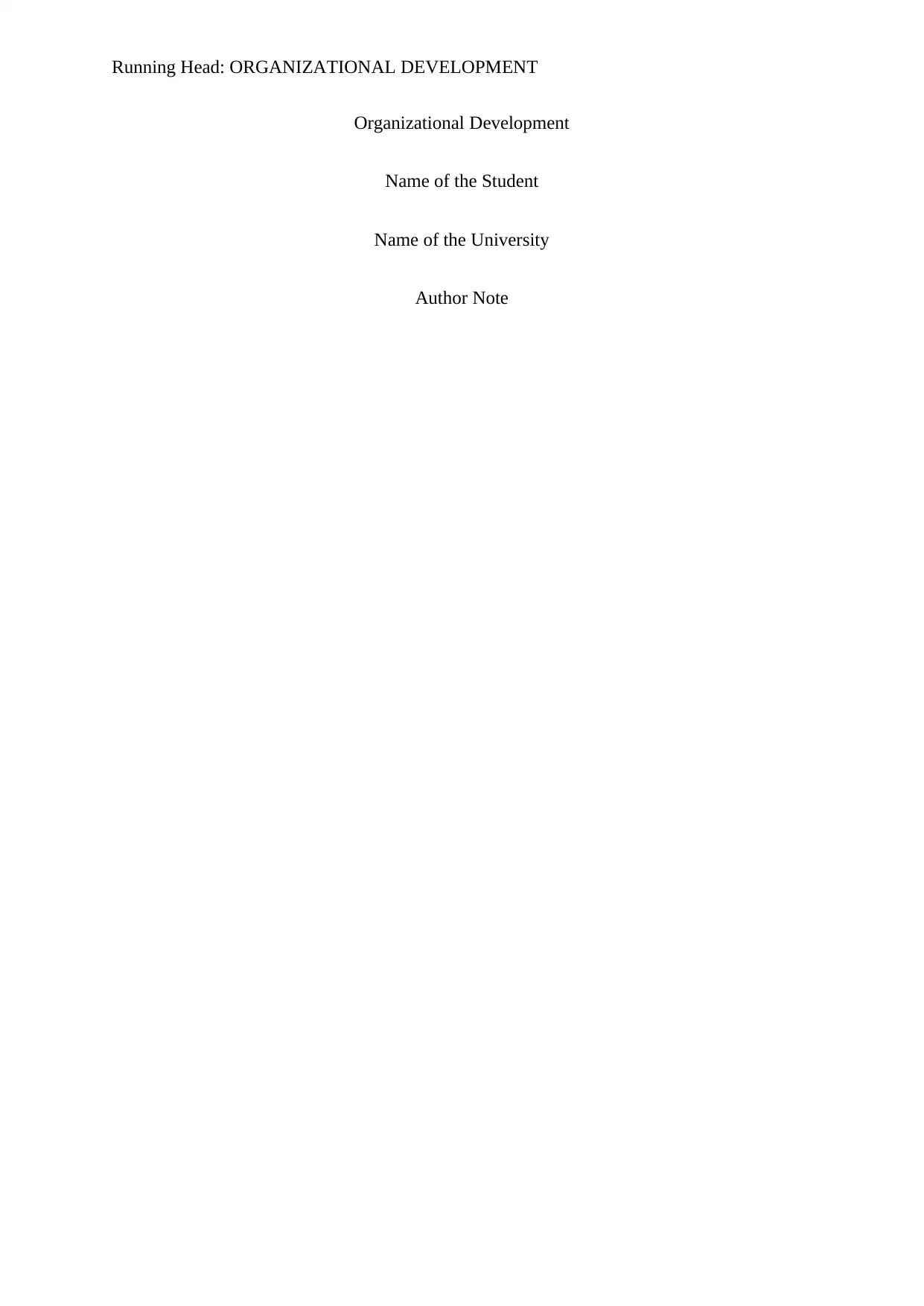
Running Head: ORGANIZATIONAL DEVELOPMENT
Organizational Development
Name of the Student
Name of the University
Author Note
Organizational Development
Name of the Student
Name of the University
Author Note
Paraphrase This Document
Need a fresh take? Get an instant paraphrase of this document with our AI Paraphraser
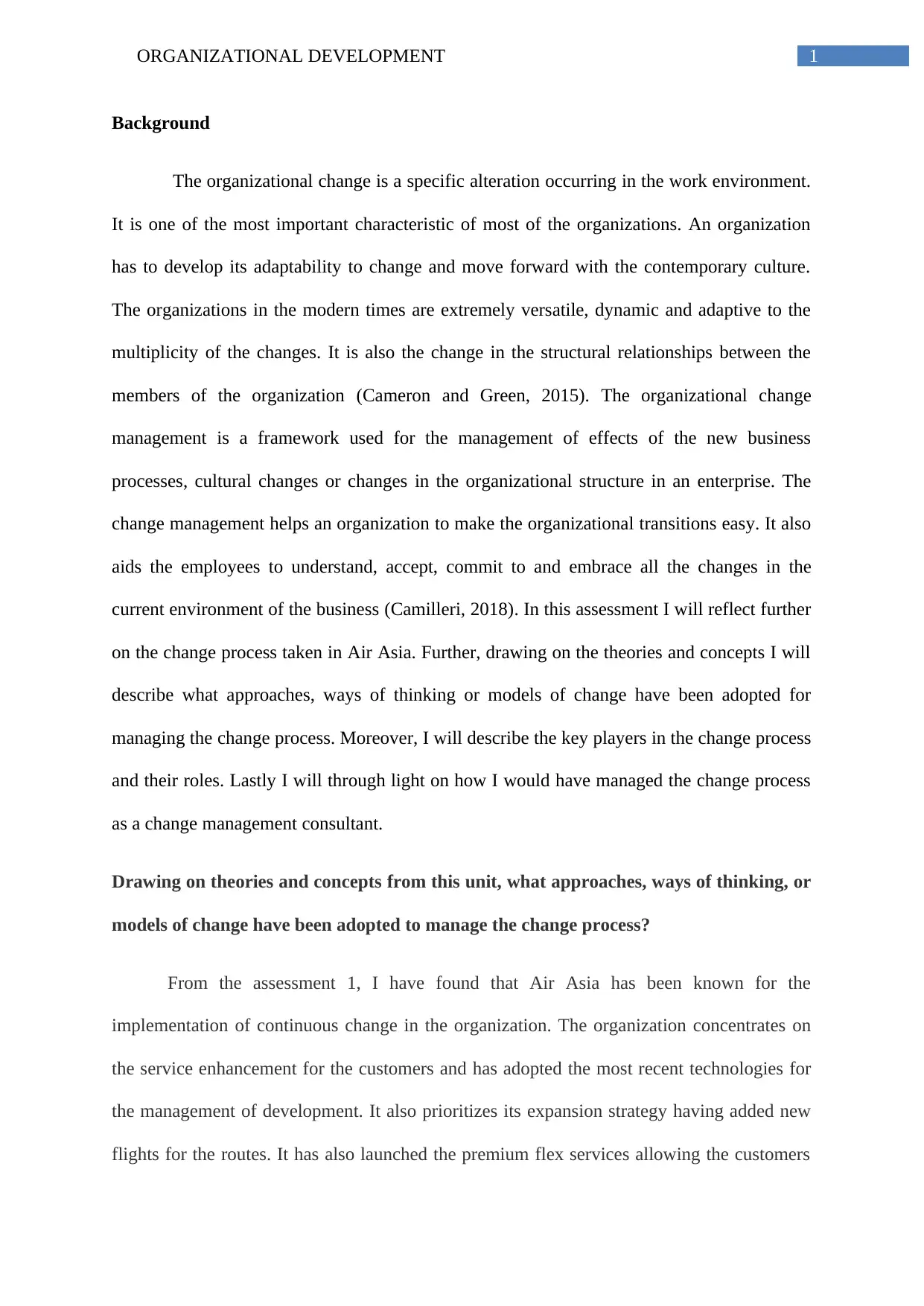
1ORGANIZATIONAL DEVELOPMENT
Background
The organizational change is a specific alteration occurring in the work environment.
It is one of the most important characteristic of most of the organizations. An organization
has to develop its adaptability to change and move forward with the contemporary culture.
The organizations in the modern times are extremely versatile, dynamic and adaptive to the
multiplicity of the changes. It is also the change in the structural relationships between the
members of the organization (Cameron and Green, 2015). The organizational change
management is a framework used for the management of effects of the new business
processes, cultural changes or changes in the organizational structure in an enterprise. The
change management helps an organization to make the organizational transitions easy. It also
aids the employees to understand, accept, commit to and embrace all the changes in the
current environment of the business (Camilleri, 2018). In this assessment I will reflect further
on the change process taken in Air Asia. Further, drawing on the theories and concepts I will
describe what approaches, ways of thinking or models of change have been adopted for
managing the change process. Moreover, I will describe the key players in the change process
and their roles. Lastly I will through light on how I would have managed the change process
as a change management consultant.
Drawing on theories and concepts from this unit, what approaches, ways of thinking, or
models of change have been adopted to manage the change process?
From the assessment 1, I have found that Air Asia has been known for the
implementation of continuous change in the organization. The organization concentrates on
the service enhancement for the customers and has adopted the most recent technologies for
the management of development. It also prioritizes its expansion strategy having added new
flights for the routes. It has also launched the premium flex services allowing the customers
Background
The organizational change is a specific alteration occurring in the work environment.
It is one of the most important characteristic of most of the organizations. An organization
has to develop its adaptability to change and move forward with the contemporary culture.
The organizations in the modern times are extremely versatile, dynamic and adaptive to the
multiplicity of the changes. It is also the change in the structural relationships between the
members of the organization (Cameron and Green, 2015). The organizational change
management is a framework used for the management of effects of the new business
processes, cultural changes or changes in the organizational structure in an enterprise. The
change management helps an organization to make the organizational transitions easy. It also
aids the employees to understand, accept, commit to and embrace all the changes in the
current environment of the business (Camilleri, 2018). In this assessment I will reflect further
on the change process taken in Air Asia. Further, drawing on the theories and concepts I will
describe what approaches, ways of thinking or models of change have been adopted for
managing the change process. Moreover, I will describe the key players in the change process
and their roles. Lastly I will through light on how I would have managed the change process
as a change management consultant.
Drawing on theories and concepts from this unit, what approaches, ways of thinking, or
models of change have been adopted to manage the change process?
From the assessment 1, I have found that Air Asia has been known for the
implementation of continuous change in the organization. The organization concentrates on
the service enhancement for the customers and has adopted the most recent technologies for
the management of development. It also prioritizes its expansion strategy having added new
flights for the routes. It has also launched the premium flex services allowing the customers
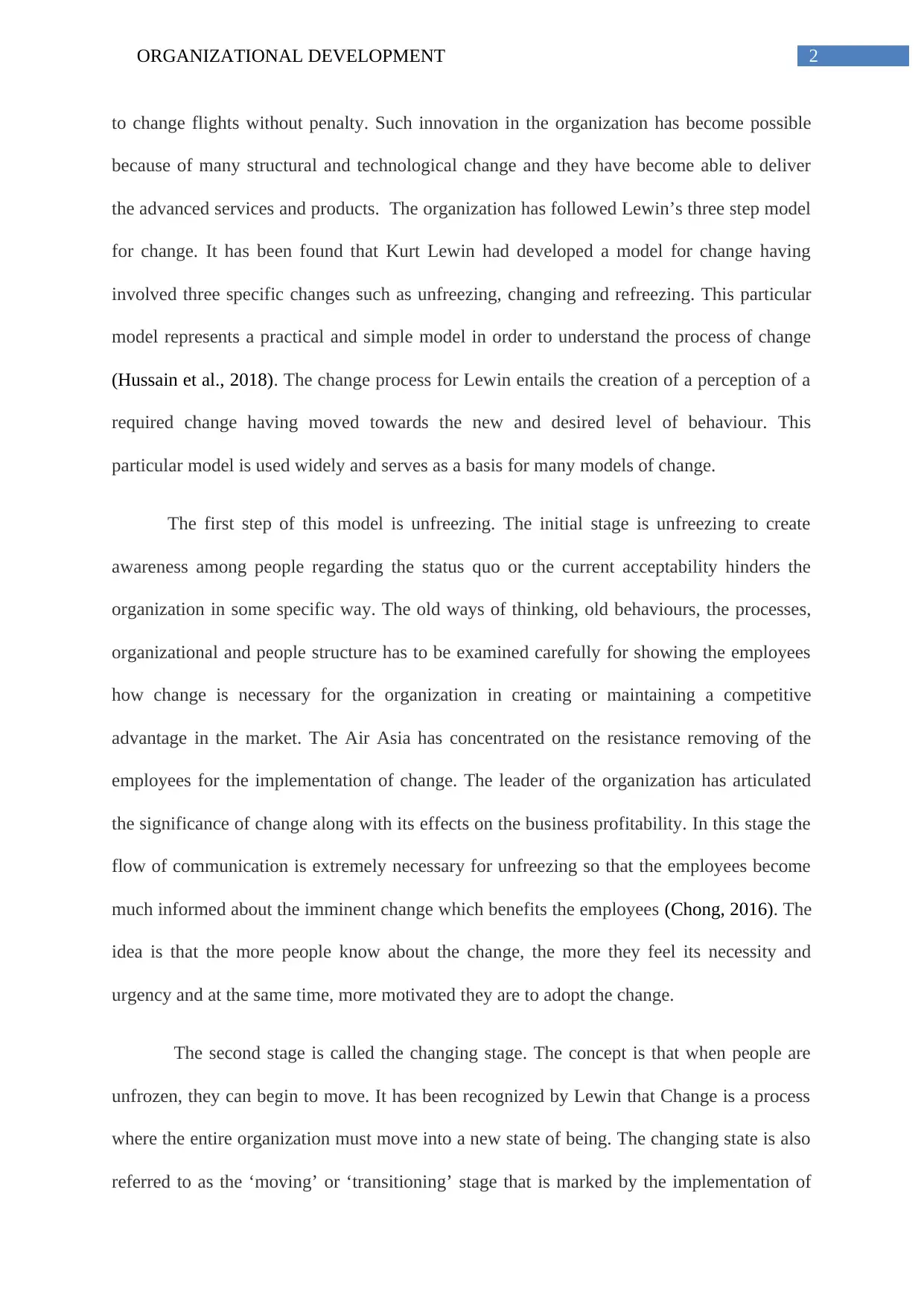
2ORGANIZATIONAL DEVELOPMENT
to change flights without penalty. Such innovation in the organization has become possible
because of many structural and technological change and they have become able to deliver
the advanced services and products. The organization has followed Lewin’s three step model
for change. It has been found that Kurt Lewin had developed a model for change having
involved three specific changes such as unfreezing, changing and refreezing. This particular
model represents a practical and simple model in order to understand the process of change
(Hussain et al., 2018). The change process for Lewin entails the creation of a perception of a
required change having moved towards the new and desired level of behaviour. This
particular model is used widely and serves as a basis for many models of change.
The first step of this model is unfreezing. The initial stage is unfreezing to create
awareness among people regarding the status quo or the current acceptability hinders the
organization in some specific way. The old ways of thinking, old behaviours, the processes,
organizational and people structure has to be examined carefully for showing the employees
how change is necessary for the organization in creating or maintaining a competitive
advantage in the market. The Air Asia has concentrated on the resistance removing of the
employees for the implementation of change. The leader of the organization has articulated
the significance of change along with its effects on the business profitability. In this stage the
flow of communication is extremely necessary for unfreezing so that the employees become
much informed about the imminent change which benefits the employees (Chong, 2016). The
idea is that the more people know about the change, the more they feel its necessity and
urgency and at the same time, more motivated they are to adopt the change.
The second stage is called the changing stage. The concept is that when people are
unfrozen, they can begin to move. It has been recognized by Lewin that Change is a process
where the entire organization must move into a new state of being. The changing state is also
referred to as the ‘moving’ or ‘transitioning’ stage that is marked by the implementation of
to change flights without penalty. Such innovation in the organization has become possible
because of many structural and technological change and they have become able to deliver
the advanced services and products. The organization has followed Lewin’s three step model
for change. It has been found that Kurt Lewin had developed a model for change having
involved three specific changes such as unfreezing, changing and refreezing. This particular
model represents a practical and simple model in order to understand the process of change
(Hussain et al., 2018). The change process for Lewin entails the creation of a perception of a
required change having moved towards the new and desired level of behaviour. This
particular model is used widely and serves as a basis for many models of change.
The first step of this model is unfreezing. The initial stage is unfreezing to create
awareness among people regarding the status quo or the current acceptability hinders the
organization in some specific way. The old ways of thinking, old behaviours, the processes,
organizational and people structure has to be examined carefully for showing the employees
how change is necessary for the organization in creating or maintaining a competitive
advantage in the market. The Air Asia has concentrated on the resistance removing of the
employees for the implementation of change. The leader of the organization has articulated
the significance of change along with its effects on the business profitability. In this stage the
flow of communication is extremely necessary for unfreezing so that the employees become
much informed about the imminent change which benefits the employees (Chong, 2016). The
idea is that the more people know about the change, the more they feel its necessity and
urgency and at the same time, more motivated they are to adopt the change.
The second stage is called the changing stage. The concept is that when people are
unfrozen, they can begin to move. It has been recognized by Lewin that Change is a process
where the entire organization must move into a new state of being. The changing state is also
referred to as the ‘moving’ or ‘transitioning’ stage that is marked by the implementation of
⊘ This is a preview!⊘
Do you want full access?
Subscribe today to unlock all pages.

Trusted by 1+ million students worldwide
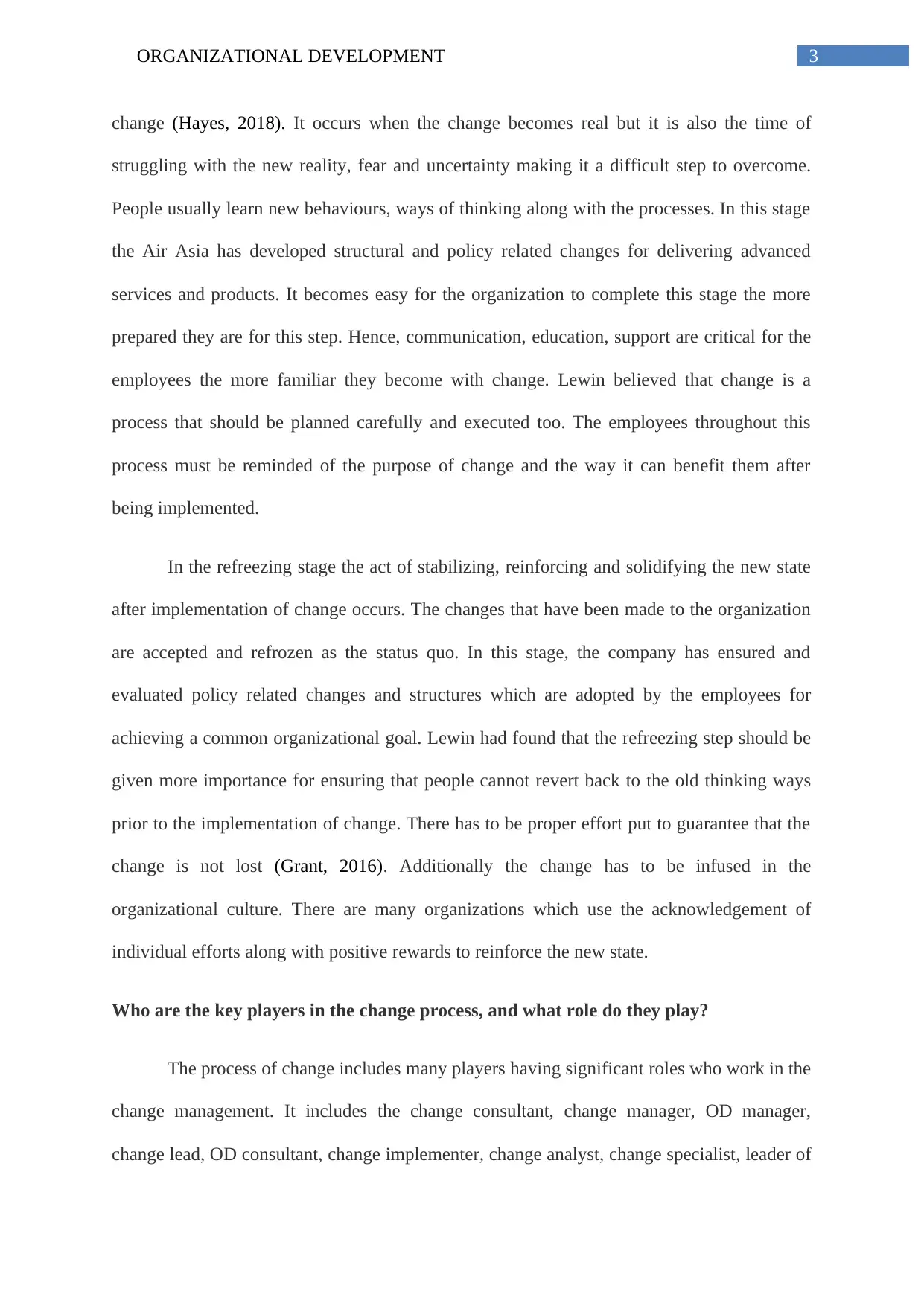
3ORGANIZATIONAL DEVELOPMENT
change (Hayes, 2018). It occurs when the change becomes real but it is also the time of
struggling with the new reality, fear and uncertainty making it a difficult step to overcome.
People usually learn new behaviours, ways of thinking along with the processes. In this stage
the Air Asia has developed structural and policy related changes for delivering advanced
services and products. It becomes easy for the organization to complete this stage the more
prepared they are for this step. Hence, communication, education, support are critical for the
employees the more familiar they become with change. Lewin believed that change is a
process that should be planned carefully and executed too. The employees throughout this
process must be reminded of the purpose of change and the way it can benefit them after
being implemented.
In the refreezing stage the act of stabilizing, reinforcing and solidifying the new state
after implementation of change occurs. The changes that have been made to the organization
are accepted and refrozen as the status quo. In this stage, the company has ensured and
evaluated policy related changes and structures which are adopted by the employees for
achieving a common organizational goal. Lewin had found that the refreezing step should be
given more importance for ensuring that people cannot revert back to the old thinking ways
prior to the implementation of change. There has to be proper effort put to guarantee that the
change is not lost (Grant, 2016). Additionally the change has to be infused in the
organizational culture. There are many organizations which use the acknowledgement of
individual efforts along with positive rewards to reinforce the new state.
Who are the key players in the change process, and what role do they play?
The process of change includes many players having significant roles who work in the
change management. It includes the change consultant, change manager, OD manager,
change lead, OD consultant, change implementer, change analyst, change specialist, leader of
change (Hayes, 2018). It occurs when the change becomes real but it is also the time of
struggling with the new reality, fear and uncertainty making it a difficult step to overcome.
People usually learn new behaviours, ways of thinking along with the processes. In this stage
the Air Asia has developed structural and policy related changes for delivering advanced
services and products. It becomes easy for the organization to complete this stage the more
prepared they are for this step. Hence, communication, education, support are critical for the
employees the more familiar they become with change. Lewin believed that change is a
process that should be planned carefully and executed too. The employees throughout this
process must be reminded of the purpose of change and the way it can benefit them after
being implemented.
In the refreezing stage the act of stabilizing, reinforcing and solidifying the new state
after implementation of change occurs. The changes that have been made to the organization
are accepted and refrozen as the status quo. In this stage, the company has ensured and
evaluated policy related changes and structures which are adopted by the employees for
achieving a common organizational goal. Lewin had found that the refreezing step should be
given more importance for ensuring that people cannot revert back to the old thinking ways
prior to the implementation of change. There has to be proper effort put to guarantee that the
change is not lost (Grant, 2016). Additionally the change has to be infused in the
organizational culture. There are many organizations which use the acknowledgement of
individual efforts along with positive rewards to reinforce the new state.
Who are the key players in the change process, and what role do they play?
The process of change includes many players having significant roles who work in the
change management. It includes the change consultant, change manager, OD manager,
change lead, OD consultant, change implementer, change analyst, change specialist, leader of
Paraphrase This Document
Need a fresh take? Get an instant paraphrase of this document with our AI Paraphraser
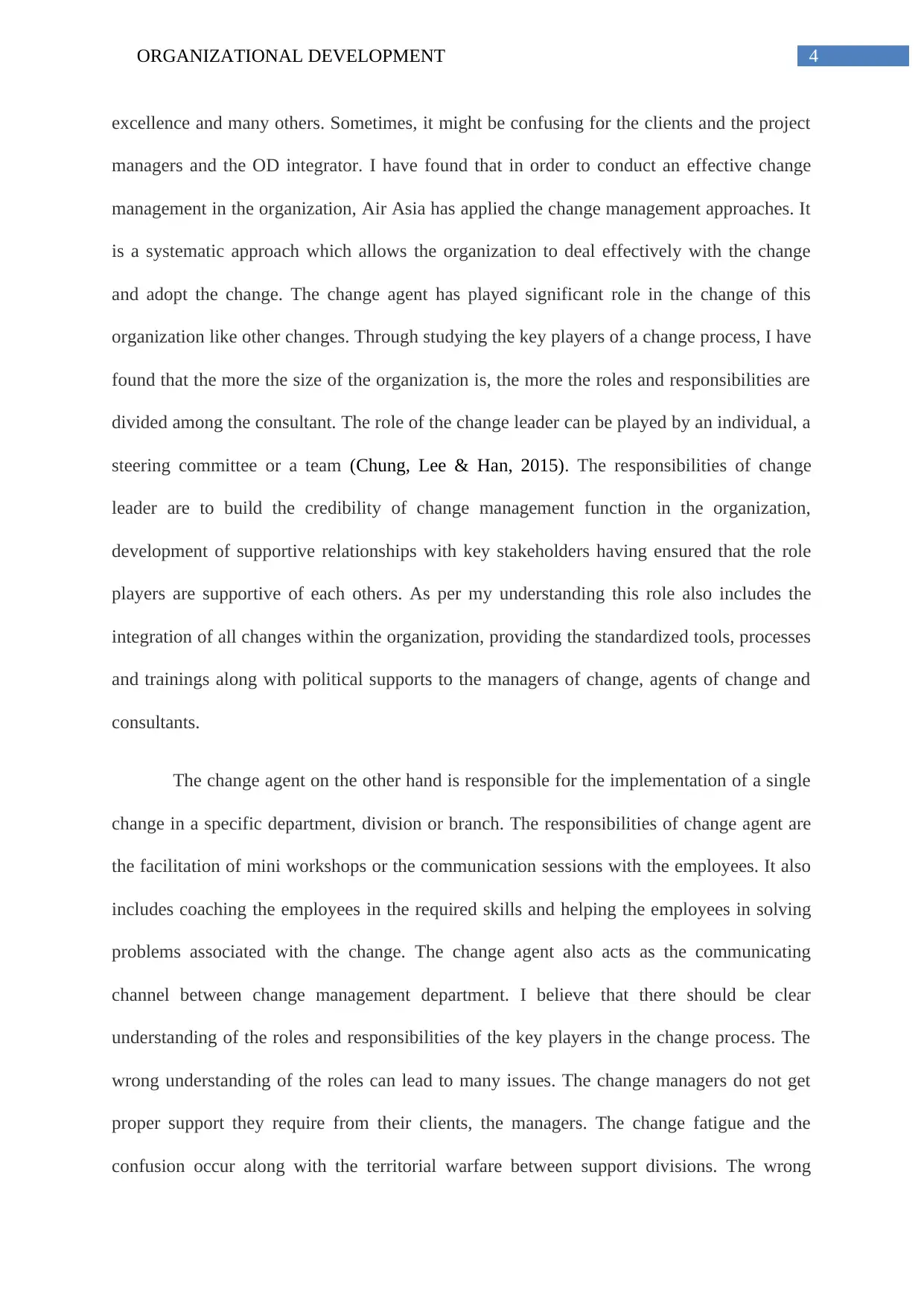
4ORGANIZATIONAL DEVELOPMENT
excellence and many others. Sometimes, it might be confusing for the clients and the project
managers and the OD integrator. I have found that in order to conduct an effective change
management in the organization, Air Asia has applied the change management approaches. It
is a systematic approach which allows the organization to deal effectively with the change
and adopt the change. The change agent has played significant role in the change of this
organization like other changes. Through studying the key players of a change process, I have
found that the more the size of the organization is, the more the roles and responsibilities are
divided among the consultant. The role of the change leader can be played by an individual, a
steering committee or a team (Chung, Lee & Han, 2015). The responsibilities of change
leader are to build the credibility of change management function in the organization,
development of supportive relationships with key stakeholders having ensured that the role
players are supportive of each others. As per my understanding this role also includes the
integration of all changes within the organization, providing the standardized tools, processes
and trainings along with political supports to the managers of change, agents of change and
consultants.
The change agent on the other hand is responsible for the implementation of a single
change in a specific department, division or branch. The responsibilities of change agent are
the facilitation of mini workshops or the communication sessions with the employees. It also
includes coaching the employees in the required skills and helping the employees in solving
problems associated with the change. The change agent also acts as the communicating
channel between change management department. I believe that there should be clear
understanding of the roles and responsibilities of the key players in the change process. The
wrong understanding of the roles can lead to many issues. The change managers do not get
proper support they require from their clients, the managers. The change fatigue and the
confusion occur along with the territorial warfare between support divisions. The wrong
excellence and many others. Sometimes, it might be confusing for the clients and the project
managers and the OD integrator. I have found that in order to conduct an effective change
management in the organization, Air Asia has applied the change management approaches. It
is a systematic approach which allows the organization to deal effectively with the change
and adopt the change. The change agent has played significant role in the change of this
organization like other changes. Through studying the key players of a change process, I have
found that the more the size of the organization is, the more the roles and responsibilities are
divided among the consultant. The role of the change leader can be played by an individual, a
steering committee or a team (Chung, Lee & Han, 2015). The responsibilities of change
leader are to build the credibility of change management function in the organization,
development of supportive relationships with key stakeholders having ensured that the role
players are supportive of each others. As per my understanding this role also includes the
integration of all changes within the organization, providing the standardized tools, processes
and trainings along with political supports to the managers of change, agents of change and
consultants.
The change agent on the other hand is responsible for the implementation of a single
change in a specific department, division or branch. The responsibilities of change agent are
the facilitation of mini workshops or the communication sessions with the employees. It also
includes coaching the employees in the required skills and helping the employees in solving
problems associated with the change. The change agent also acts as the communicating
channel between change management department. I believe that there should be clear
understanding of the roles and responsibilities of the key players in the change process. The
wrong understanding of the roles can lead to many issues. The change managers do not get
proper support they require from their clients, the managers. The change fatigue and the
confusion occur along with the territorial warfare between support divisions. The wrong
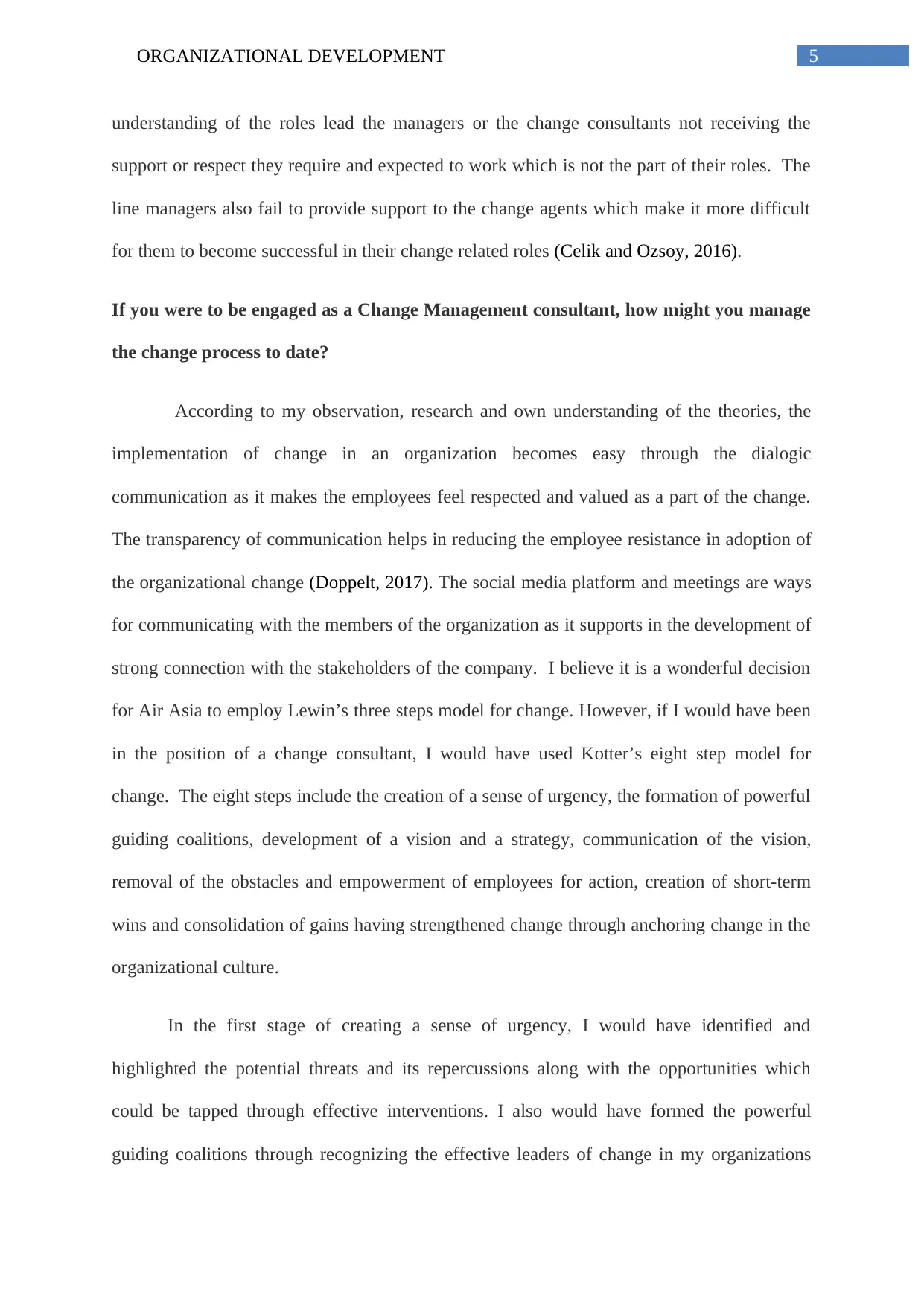
5ORGANIZATIONAL DEVELOPMENT
understanding of the roles lead the managers or the change consultants not receiving the
support or respect they require and expected to work which is not the part of their roles. The
line managers also fail to provide support to the change agents which make it more difficult
for them to become successful in their change related roles (Celik and Ozsoy, 2016).
If you were to be engaged as a Change Management consultant, how might you manage
the change process to date?
According to my observation, research and own understanding of the theories, the
implementation of change in an organization becomes easy through the dialogic
communication as it makes the employees feel respected and valued as a part of the change.
The transparency of communication helps in reducing the employee resistance in adoption of
the organizational change (Doppelt, 2017). The social media platform and meetings are ways
for communicating with the members of the organization as it supports in the development of
strong connection with the stakeholders of the company. I believe it is a wonderful decision
for Air Asia to employ Lewin’s three steps model for change. However, if I would have been
in the position of a change consultant, I would have used Kotter’s eight step model for
change. The eight steps include the creation of a sense of urgency, the formation of powerful
guiding coalitions, development of a vision and a strategy, communication of the vision,
removal of the obstacles and empowerment of employees for action, creation of short-term
wins and consolidation of gains having strengthened change through anchoring change in the
organizational culture.
In the first stage of creating a sense of urgency, I would have identified and
highlighted the potential threats and its repercussions along with the opportunities which
could be tapped through effective interventions. I also would have formed the powerful
guiding coalitions through recognizing the effective leaders of change in my organizations
understanding of the roles lead the managers or the change consultants not receiving the
support or respect they require and expected to work which is not the part of their roles. The
line managers also fail to provide support to the change agents which make it more difficult
for them to become successful in their change related roles (Celik and Ozsoy, 2016).
If you were to be engaged as a Change Management consultant, how might you manage
the change process to date?
According to my observation, research and own understanding of the theories, the
implementation of change in an organization becomes easy through the dialogic
communication as it makes the employees feel respected and valued as a part of the change.
The transparency of communication helps in reducing the employee resistance in adoption of
the organizational change (Doppelt, 2017). The social media platform and meetings are ways
for communicating with the members of the organization as it supports in the development of
strong connection with the stakeholders of the company. I believe it is a wonderful decision
for Air Asia to employ Lewin’s three steps model for change. However, if I would have been
in the position of a change consultant, I would have used Kotter’s eight step model for
change. The eight steps include the creation of a sense of urgency, the formation of powerful
guiding coalitions, development of a vision and a strategy, communication of the vision,
removal of the obstacles and empowerment of employees for action, creation of short-term
wins and consolidation of gains having strengthened change through anchoring change in the
organizational culture.
In the first stage of creating a sense of urgency, I would have identified and
highlighted the potential threats and its repercussions along with the opportunities which
could be tapped through effective interventions. I also would have formed the powerful
guiding coalitions through recognizing the effective leaders of change in my organizations
⊘ This is a preview!⊘
Do you want full access?
Subscribe today to unlock all pages.

Trusted by 1+ million students worldwide
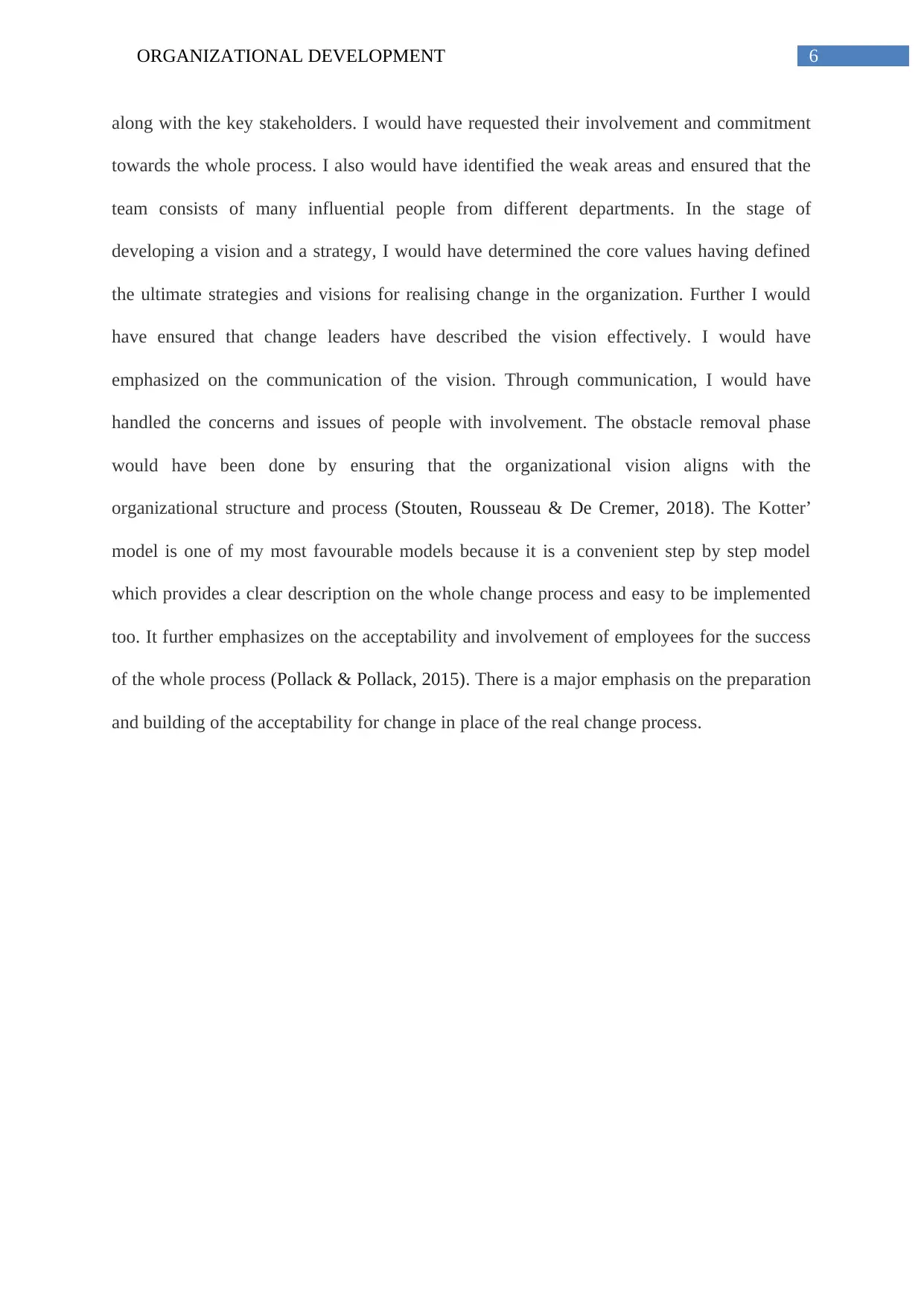
6ORGANIZATIONAL DEVELOPMENT
along with the key stakeholders. I would have requested their involvement and commitment
towards the whole process. I also would have identified the weak areas and ensured that the
team consists of many influential people from different departments. In the stage of
developing a vision and a strategy, I would have determined the core values having defined
the ultimate strategies and visions for realising change in the organization. Further I would
have ensured that change leaders have described the vision effectively. I would have
emphasized on the communication of the vision. Through communication, I would have
handled the concerns and issues of people with involvement. The obstacle removal phase
would have been done by ensuring that the organizational vision aligns with the
organizational structure and process (Stouten, Rousseau & De Cremer, 2018). The Kotter’
model is one of my most favourable models because it is a convenient step by step model
which provides a clear description on the whole change process and easy to be implemented
too. It further emphasizes on the acceptability and involvement of employees for the success
of the whole process (Pollack & Pollack, 2015). There is a major emphasis on the preparation
and building of the acceptability for change in place of the real change process.
along with the key stakeholders. I would have requested their involvement and commitment
towards the whole process. I also would have identified the weak areas and ensured that the
team consists of many influential people from different departments. In the stage of
developing a vision and a strategy, I would have determined the core values having defined
the ultimate strategies and visions for realising change in the organization. Further I would
have ensured that change leaders have described the vision effectively. I would have
emphasized on the communication of the vision. Through communication, I would have
handled the concerns and issues of people with involvement. The obstacle removal phase
would have been done by ensuring that the organizational vision aligns with the
organizational structure and process (Stouten, Rousseau & De Cremer, 2018). The Kotter’
model is one of my most favourable models because it is a convenient step by step model
which provides a clear description on the whole change process and easy to be implemented
too. It further emphasizes on the acceptability and involvement of employees for the success
of the whole process (Pollack & Pollack, 2015). There is a major emphasis on the preparation
and building of the acceptability for change in place of the real change process.
Paraphrase This Document
Need a fresh take? Get an instant paraphrase of this document with our AI Paraphraser
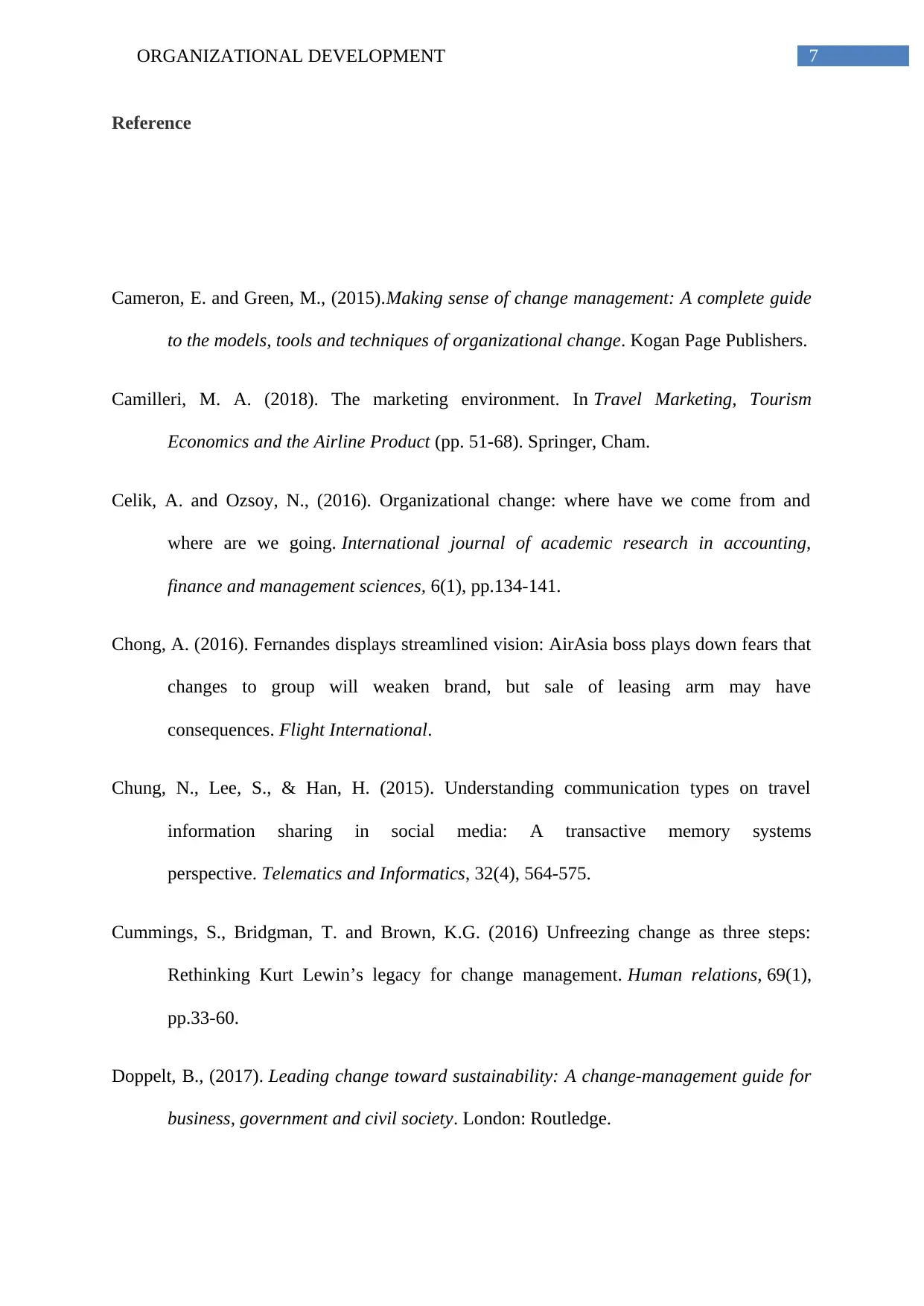
7ORGANIZATIONAL DEVELOPMENT
Reference
Cameron, E. and Green, M., (2015).Making sense of change management: A complete guide
to the models, tools and techniques of organizational change. Kogan Page Publishers.
Camilleri, M. A. (2018). The marketing environment. In Travel Marketing, Tourism
Economics and the Airline Product (pp. 51-68). Springer, Cham.
Celik, A. and Ozsoy, N., (2016). Organizational change: where have we come from and
where are we going. International journal of academic research in accounting,
finance and management sciences, 6(1), pp.134-141.
Chong, A. (2016). Fernandes displays streamlined vision: AirAsia boss plays down fears that
changes to group will weaken brand, but sale of leasing arm may have
consequences. Flight International.
Chung, N., Lee, S., & Han, H. (2015). Understanding communication types on travel
information sharing in social media: A transactive memory systems
perspective. Telematics and Informatics, 32(4), 564-575.
Cummings, S., Bridgman, T. and Brown, K.G. (2016) Unfreezing change as three steps:
Rethinking Kurt Lewin’s legacy for change management. Human relations, 69(1),
pp.33-60.
Doppelt, B., (2017). Leading change toward sustainability: A change-management guide for
business, government and civil society. London: Routledge.
Reference
Cameron, E. and Green, M., (2015).Making sense of change management: A complete guide
to the models, tools and techniques of organizational change. Kogan Page Publishers.
Camilleri, M. A. (2018). The marketing environment. In Travel Marketing, Tourism
Economics and the Airline Product (pp. 51-68). Springer, Cham.
Celik, A. and Ozsoy, N., (2016). Organizational change: where have we come from and
where are we going. International journal of academic research in accounting,
finance and management sciences, 6(1), pp.134-141.
Chong, A. (2016). Fernandes displays streamlined vision: AirAsia boss plays down fears that
changes to group will weaken brand, but sale of leasing arm may have
consequences. Flight International.
Chung, N., Lee, S., & Han, H. (2015). Understanding communication types on travel
information sharing in social media: A transactive memory systems
perspective. Telematics and Informatics, 32(4), 564-575.
Cummings, S., Bridgman, T. and Brown, K.G. (2016) Unfreezing change as three steps:
Rethinking Kurt Lewin’s legacy for change management. Human relations, 69(1),
pp.33-60.
Doppelt, B., (2017). Leading change toward sustainability: A change-management guide for
business, government and civil society. London: Routledge.
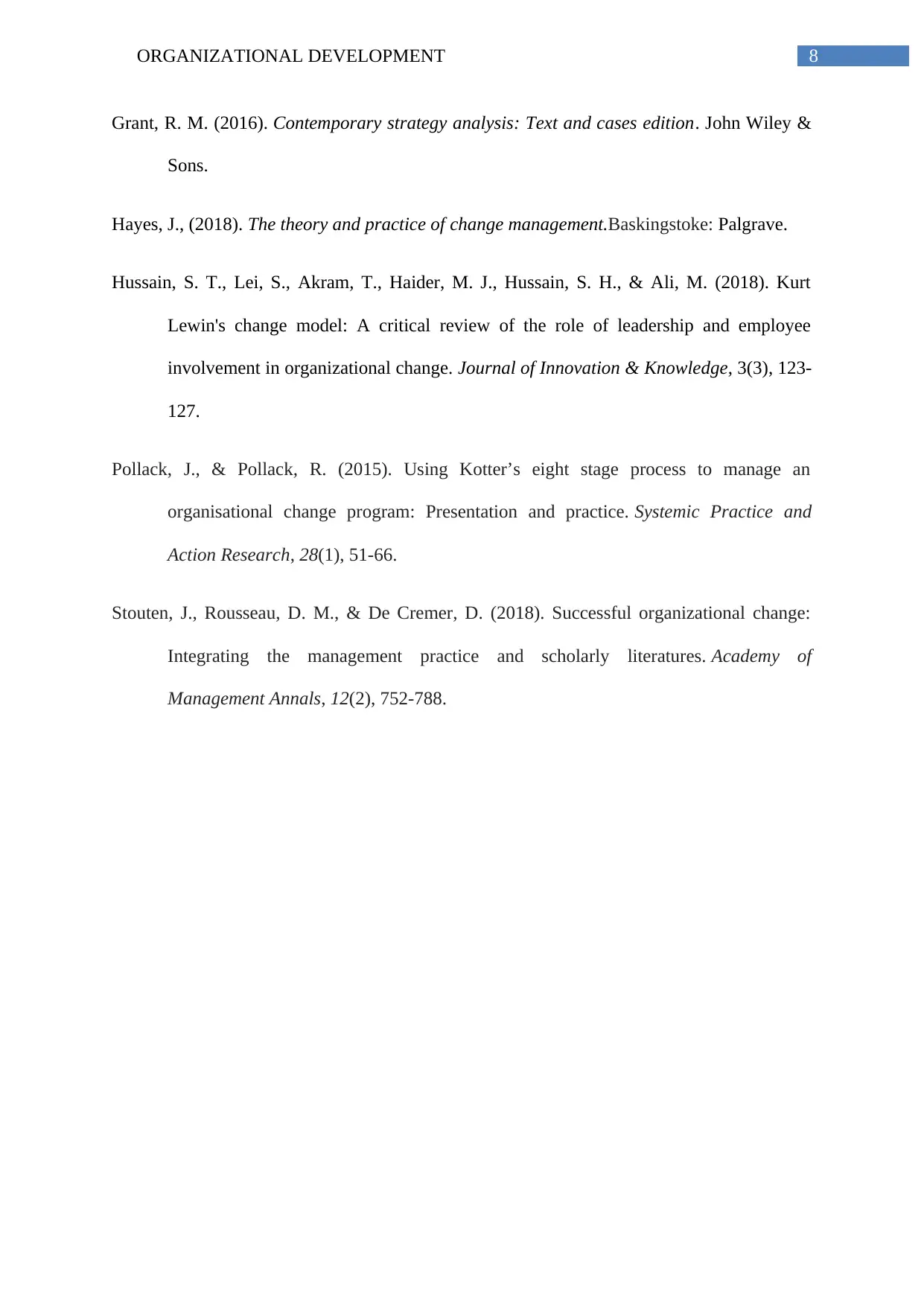
8ORGANIZATIONAL DEVELOPMENT
Grant, R. M. (2016). Contemporary strategy analysis: Text and cases edition. John Wiley &
Sons.
Hayes, J., (2018). The theory and practice of change management.Baskingstoke: Palgrave.
Hussain, S. T., Lei, S., Akram, T., Haider, M. J., Hussain, S. H., & Ali, M. (2018). Kurt
Lewin's change model: A critical review of the role of leadership and employee
involvement in organizational change. Journal of Innovation & Knowledge, 3(3), 123-
127.
Pollack, J., & Pollack, R. (2015). Using Kotter’s eight stage process to manage an
organisational change program: Presentation and practice. Systemic Practice and
Action Research, 28(1), 51-66.
Stouten, J., Rousseau, D. M., & De Cremer, D. (2018). Successful organizational change:
Integrating the management practice and scholarly literatures. Academy of
Management Annals, 12(2), 752-788.
Grant, R. M. (2016). Contemporary strategy analysis: Text and cases edition. John Wiley &
Sons.
Hayes, J., (2018). The theory and practice of change management.Baskingstoke: Palgrave.
Hussain, S. T., Lei, S., Akram, T., Haider, M. J., Hussain, S. H., & Ali, M. (2018). Kurt
Lewin's change model: A critical review of the role of leadership and employee
involvement in organizational change. Journal of Innovation & Knowledge, 3(3), 123-
127.
Pollack, J., & Pollack, R. (2015). Using Kotter’s eight stage process to manage an
organisational change program: Presentation and practice. Systemic Practice and
Action Research, 28(1), 51-66.
Stouten, J., Rousseau, D. M., & De Cremer, D. (2018). Successful organizational change:
Integrating the management practice and scholarly literatures. Academy of
Management Annals, 12(2), 752-788.
⊘ This is a preview!⊘
Do you want full access?
Subscribe today to unlock all pages.

Trusted by 1+ million students worldwide
1 out of 9
Related Documents
Your All-in-One AI-Powered Toolkit for Academic Success.
+13062052269
info@desklib.com
Available 24*7 on WhatsApp / Email
![[object Object]](/_next/static/media/star-bottom.7253800d.svg)
Unlock your academic potential
Copyright © 2020–2025 A2Z Services. All Rights Reserved. Developed and managed by ZUCOL.




